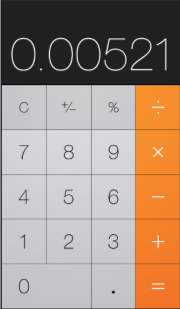Spotify is not paying sustainable rates for the cost of goods. Look – it’s like this, if something cost you $100 to make, and someone else sells it for $10… it doesn’t matter that you are getting 70% of the gross, you’re still over 90% unrecouped on a per unit basis. This is the problem with Spotify, is that it undervalues the true cost of goods (including R&D, etc).
Artists agreeing to streaming their music on Spotify are essentially agreeing to sell albums for One Dollar and Songs for Ten Cents… Oh Wait, Spotfiy actually pays way less than that… (calculated on a per stream basis).
This is why arguments about marginal percentages miss the point completely. It’s about simple math and simple economics.
The cost of music is not in the distribution of music (which is cheap). The cost of music is in the human labor of the CREATION of music (which is expensive).
The cost of goods is greater than the marginal cost to distribute those goods. Stop confusing the product with the container.
The CREATION of music is also more than the cost of RECORDING music. The cost of music is in the sustainable needs of the human labor for food, shelter, clothing, etc.
Spotify can not scale and work at current economics… One More Time…
SPOTIFY MATH FOR THOSE OF YOU AT HOME WITH CALCULATORS:
Just show us the math where streaming scales, we’ll wait. Spotify has 3m paid in the US at $10 each.
$10 x 12 mos = $120 per year. Pay out 70% that’s a gross of $84 per year per subscriber. Simple Math.
That $84 per sub is in revenue to all artists in rights holders. Times that by 3m and you get a whopping $252m a year in a $7b business.
Multiple that by 10, to get 30m subs @ $10a month and that’s only $2.5b a year… and that’s a big IF Spotify ever gets to 30m paid in the USA… and IF they do, that’s ONLY 2.5b in revenue against the $7b now…
So you effectively cut the revenue to everyone by 1/2 to 2/3rds… how does this math work without raising the price of subscriptions? It doesn’t.
It’s just math.
RELATED:


I’m 100% in agreement with this. Spotify is like ‘tulip mania’ an over hyped bubble of craziness that has investors, consumers, musicians and distributors in a frenzy. It’s unsustainable but also unethical and shouldn’t be allowed to exist.
and I’d add: who cares if it’s fair? Are we supposed to care if they pay out all of their money trying to keep their business model alive?
Unfortunately, this is highly selective math, of the type that got many companies in trouble a few years back.
First, the math ignores monies made from advertising with Spotify’s free users. This money is certainly far lower than subscription money, but it’s still real money. For the sake of argument, let’s lowball it at 20% of subscription monies. At the $252m generated today, this would add another $50m in royalties. Not massive, but something.
If, in your example, Spotify does indeed have 30m paying subs, then in the current model they would also have increased the advertising base. If they go from 10m to 100m free users, they’ll be able to charge much larger premium rates, and may even strike deals with some acts. That could easily result in $1b in artist royalties, given some other media models. This now puts Spotify at $3.5b in artist royalties per year. Pretty good.
To your point, though, that’s still half of the $7b number you put out there. True, but that presumes that Spotify is the only player in town. While they may be a major force, there will also be other internet radio, satellite radio, video streaming, other streaming competitors and probably still physical and digital retail sales. Add to that greater ubiquity in tracking usage with increasing penetration of smart mobile devices combined with declining mobile data cost…and I feel like we’re starting to approach $10b a year.
And that’s just the U.S.
Like most digital utopianists you fundamentally fail to understand basic economics and human nature. Why would anyone pay for netflix if the exact same service were offered for free? How do you get to 100 million subscribers when cable has 56 million? Multiple services? So we will have 200 million streaming service subscribers in YS? You are all living in a fantasy land. The god of free is dead. It’s no longer 2006. Come over here into the world of facts, logic and observable human behavior. It’s only math. The water is fine.
Just to clarify, you’re comparing Spotify worldwide subscribers to US cable subscribers.
Great news, Jay, we’ll make it up on volume! Whew, I thought we had another dot bomb economics problem! But why don’t we use the rate that Billboard uses for their chart that 100 streams equals one download–$0.007 per stream at a $0.70 wholesale price. Or even better the rate that Spotify’s Mark Williamson says is the correct one of 80 streams equals 1 download–$0.00875. Isn’t that wonderful news? And here I thought the ad supported tier was in the range of $0.000899194. We’re all rich now and we didn’t even know it. And that must solve the problem of dynamic denominators, too, right? Because those are fixed rates. We don’t have to worry about rev share denominators growing faster than numerators according to Spotify. And here’s another great thing, Spotify says the artist rates are calculated on the combined artist and publisher shares of revenue. Wowza! PS, anybody checked whose royalty system can handle royalty rates that go out 10 decimal places? Well, the geniuses solved Y2K, right, so they can solve the Y4Spotify problem, too.